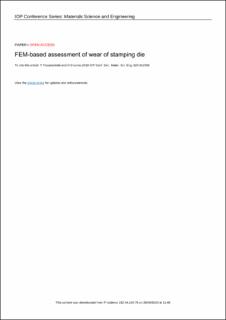| dc.contributor.author | Trzepiecinski, Thomasz | |
| dc.contributor.author | Lemu, Hirpa G. | |
| dc.date.accessioned | 2023-02-01T12:21:29Z | |
| dc.date.available | 2023-02-01T12:21:29Z | |
| dc.date.created | 2019-08-09T22:51:19Z | |
| dc.date.issued | 2019 | |
| dc.identifier.citation | Trzepiecinski, T., & Lemu, H. G. (2019, June). FEM-based assessment of wear of stamping die. In IOP Conference Series: Materials Science and Engineering (Vol. 526, No. 1, p. 012002). IOP Publishing. | en_US |
| dc.identifier.issn | 1757-8981 | |
| dc.identifier.uri | https://hdl.handle.net/11250/3047708 | |
| dc.description.abstract | In sheet metal forming industry, surface damage and wear such as adhesion and ploughing of metallic sheet, is a well-known problem which reduces the tool life and quality of drawn elements. Surface defects are the consequences of wear and they accelerate the galling process. The knowledge of places particularly endanger wear allows appropriate design of tools. In this paper, an investigation that focused on the finite element-based analysis of wear of stamping tool for forming an axisymmetric drawpiece has been reported. The analyses were carried out for deep-drawing quality steel sheet with a sheet thickness of 2 mm. The basic mechanical parameters of the sheet tested are determined in uniaxial tensile tests. The analyses performed using Marc/Mentat program for nonlinear analyses take into account the strain hardening phenomenon of sheet material and different values of friction coefficient. The implementation of an Archard’s wear model in the numerical simulation proved the possibility of tool wear simulation in sheet metal forming. As a result of the conducted tests, the places of the stamping die potentially exposed to quick wear were determined. It was found that the most exposed region on accelerated wear is the upper part of the die radius. | en_US |
| dc.language.iso | eng | en_US |
| dc.publisher | IOP Publishing | en_US |
| dc.rights | Navngivelse 4.0 Internasjonal | * |
| dc.rights.uri | http://creativecommons.org/licenses/by/4.0/deed.no | * |
| dc.title | FEM-based assessment of wear of stamping die | en_US |
| dc.type | Peer reviewed | en_US |
| dc.type | Journal article | en_US |
| dc.description.version | publishedVersion | en_US |
| dc.rights.holder | The authors | en_US |
| dc.subject.nsi | VDP::Teknologi: 500 | en_US |
| dc.source.volume | 526 | en_US |
| dc.source.journal | IOP Conference Series: Materials Science and Engineering | en_US |
| dc.identifier.doi | 10.1088/1757-899X/526/1/012002 | |
| dc.identifier.cristin | 1715116 | |
| cristin.ispublished | true | |
| cristin.fulltext | original | |
| cristin.qualitycode | 1 | |

